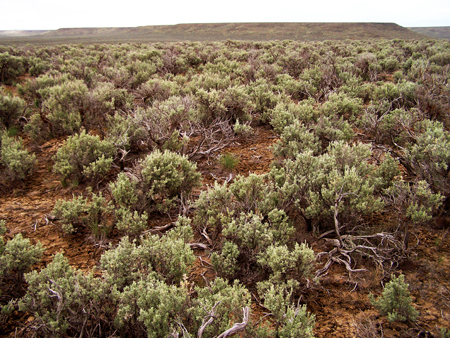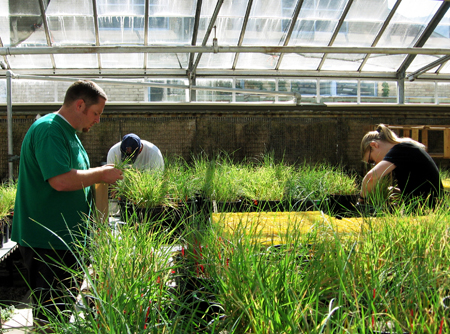Researchers
Dara Scherpenisse, M.S., Utah State University, [email protected]
Gene Schupp
Study Dates
05/2006 to 10/2008
SageSTEP Study Plots
Study Design and Objectives
The invasion of cheatgrass (Bromus tectorum) in sagebrush communities has led to a reduction in native species establishment due to the cheatgrass-fire cycle in which cheatgrass fuels fire and then fire enables increased growth of cheatgrass. As land managers and researchers have struggled to restore these highly disturbed sagebrush systems, it has become evident that alternatives to the typical seeding treatment need to be researched and developed. One possibility is the use of mycorrhizae. Mycorrhizae are fungi that can form a symbiotic association with the roots of a plant, and can help plants capture nutrients, especially during initial colonization. They have been used for decades to improve establishment and restoration of desired plant species. However, studies assessing the use of mycorrhizae in cheatgrass-invaded areas of the Great Basin are limited. A recent study conducted on SageSTEP plots by Dara Scherpenisse of Utah State University, proposes that the use of arbuscular mycorrhizal fungi (AMF) in restoration may help increase the competitive ability of native perennial grasses.
AMF occur naturally in wildland soils throughout the Great Basin. When moderate- or high-intensity fires occur they can greatly reduce or eliminate AMF propagules near the soil surface, but AMF propagules from nearby unburned areas or from deeper in the soil profile can re-colonize the upper soil layers quickly. However, even a temporary post-fire reduction of AMF propagules or changes in AMF species composition may prohibit the re-establishment of desirable perennial species and help perpetuate the cheatgrass-fire cycle. Scherpenisse took soil samples from the SageSTEP Onaqui study site to culture the local AMF innoculum, and then conducted greenhouse pot experiments with two main objectives:
- Evaluate the general response of bluebunch wheatgrass (Pseudoroegneria spicatum), squirreltail (Elymus elymoides), and cheatgrass to mycorrhizal symbiosis by measuring how these species’ morphology and physiology change under different environmental conditions (levels of phosphorus (P), water availability, and plant density).
- Determine the role of different inocula in competition among the three grasses. A competition study evaluated how the three species responded to local and commercial inocula under competition among the three species (interspecific) and within each species (intraspecific).

Restoration of sagebrush landscapes after fire may benefit from the use of
arbuscular mycorrhizal fungi (AMF), which are found naturally in soil and may help
with the establishment of new plants.

Two greenhouse pot experiments were conducted to provide information about
when and how mycorrhizae could be used in restoring sagebrush communities.
General Response Study
In this study, bluebunch wheatgrass, squirreltail and cheatgrass were examined for their responses to commercial inoculum. The inoculum used had a mixture of AMF species, increasing the likelihood that the AMF would be compatible with the grass species. Plant density, P, and water availability were altered to test the effect of different stressors on responses to inoculum. Contrary to expectations, mycorrhizae had minimal effects on the invasive and native grass species. When mycorrhizae did have an effect it was often negative, which is not unusual for cheatgrass since it is not considered a mycorrhizal-dependent species. However, the negative effect is atypical for bluebunch wheatgrass and squirreltail, which are considered mycorrhizal-dependent species.
These neutral and negative effects of mycorrhizae were likely evidence of resources being readily available, particularly P, but also water, rendering the mycorrhizal fungi unnecessary. The mycorrhizal effects could also be due to the artificial conditions in the greenhouse. These results suggest that mycorrhizal relationship range along a parasitic-mutualistic continuum depending on environmental conditions. Under poor environmental conditions, mycorrhizae are beneficial because they increase access to resources whereas when resources are readily available, the plants can access resources without mycorrhizal help, possibly resulting in a parasite-like mycorrhizal fungal effect. This highlights the importance for land managers and researchers to evaluate the abiotic status of their system before applying mycorrhizae in restoration. In some cases, mycorrhizae may not be a successful restoration tool and may be detrimental to the native species if not used wisely.
Competition Study
This study addressed how mycorrhizae altered the competitive relationship between cheatgrass and the native perennial grasses, and whether the mycorrhizal effect on competition varied with local inoculum versus commercial inoculum. In this experiment, plants experienced greater water and P stress compared to the first experiment. While both inocula generally benefited all three species in this experiment, the local inoculum tended to have a greater benefit, especially for cheatgrass. However, some of the mycorrhizal responses of the native perennial grass species suggest that during interspecific competition the commercial inoculum may be more beneficial than local inoculum for these perennial species.
Interestingly, the local inoculum in general was beneficial to the perennials, but it was even more beneficial to cheatgrass. Some response variables suggested that cheatgrass took greater advantage of the local inoculum when competing with squirreltail. The mean number of tillers (sprouts or stalks) per cheatgrass plant suggested that this plant took advantage of local inoculum when there was a greater proportion of native plants than of invasive plants in a pot.
Management Applications
The results of this study demonstrate the complex dynamics of the mycorrhizal plant-fungus relationship. One particular inoculum is not necessarily always the best choice for a particular plant species. The choice of inoculum may depend on what plant physiological or morphological trait land managers and researchers consider the best indicator of competitive ability. Is greater shoot growth, root growth, or seed production ultimately desired? Land managers must also take into account how the inoculum will affect the desirable species’ competitors and how the response of desirable species to AMF will fluctuate with varying environmental condition. The question of whether or not to use mycorrhizae and what type to use does not have a simple answer due to the ever-changing conditions of ecological systems. The competition study clearly shows that inoculum can greatly benefit the non-desirable species, in some cases even more so than the desirable species.
In any case, unless land managers are working in a static system and have thorough knowledge of their plant community’s response to different AMF species, an AMF mixture is likely the best choice for inoculum. Ideally before applying inocula on a large scale project, land managers could do trial experiments to determine the desirable and non-desirable plant species responses to inocula, though given time constraints this might be difficult to achieve. Over the long-term, land managers and researchers may ultimately be able to determine the best mixture of AMF species to use for inoculum in systems that have a wide range of environmental conditions
For a full description of this study, please see the following reference:
Scherpenisse, D.S. 2009. Mycorrhizae in sagebrush-steppe community restoration: mycorrhizal dependency of invasive and native grasses with intraspecific and interspecific competition. M.S. Thesis, Utah State University, Logan, Utah. Available here.
